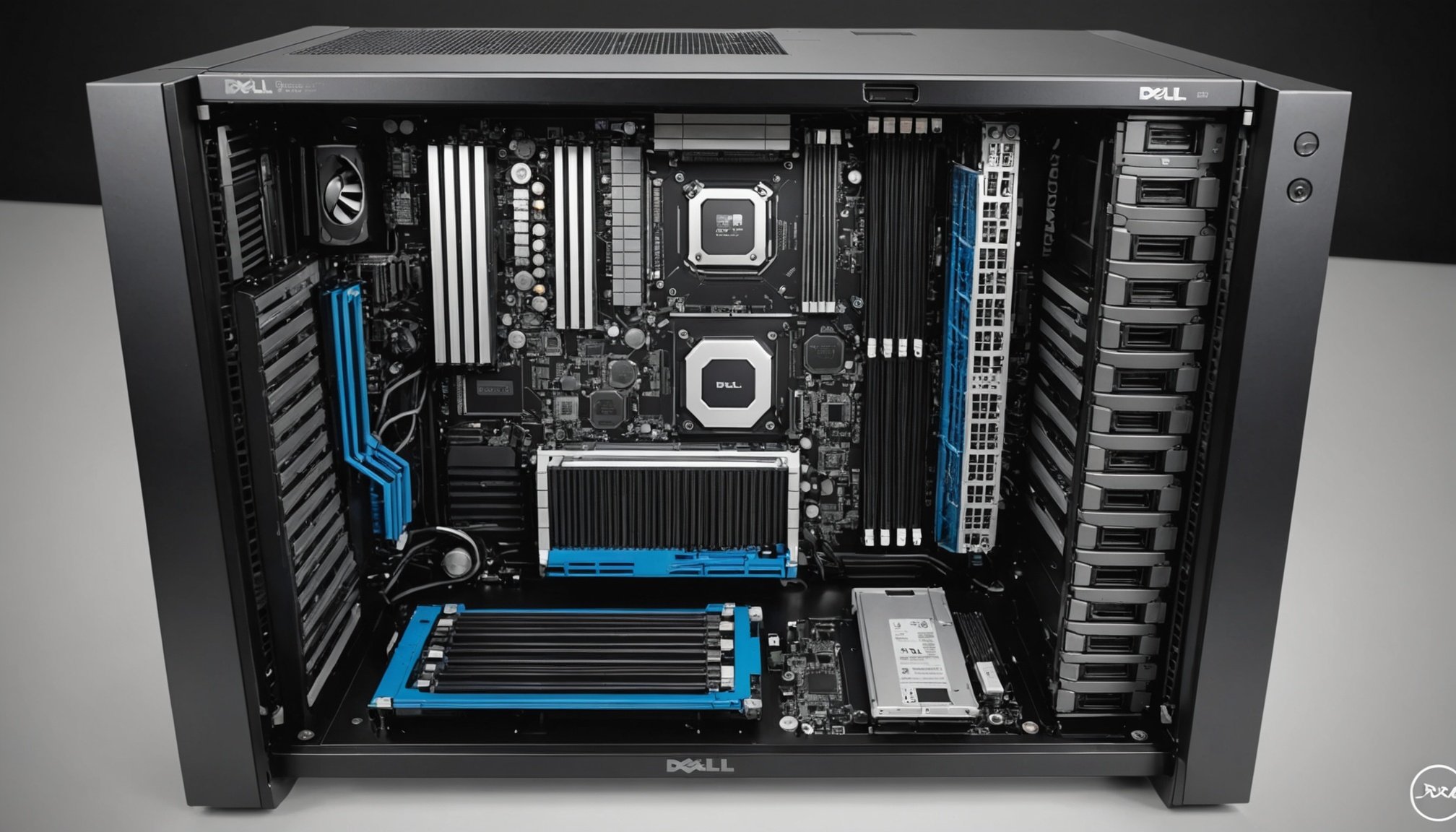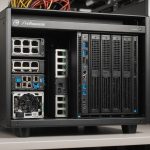Overview of the Dell Precision 5820 Tower and High-End GPU Compatibility
When considering the Dell Precision 5820, understanding its specifications for high-end GPU compatibility is vital for those working with machine learning hardware. This powerful workstation is designed with flexibility in mind, accommodating a range of GPUs to suit intensive computational tasks.
The Precision 5820 supports multiple high-end GPU configurations, providing extensive options for upgrading your machine learning hardware. It is equipped with ample space and power to meet the demands of modern GPUs, which are crucial for tasks requiring high computational capabilities.
Topic to read : Ultimate diy guide: how to set up and configure your freenas nas on a custom-built server
Supported High-End GPUs
The Dell Precision 5820 is compatible with leading high-end GPUs, such as NVIDIA’s Quadro and GeForce series, and AMD’s Radeon Pro and Radeon RX series. These GPUs are chosen for their ability to deliver optimal performance across a multitude of applications, including deep learning and AI model training. Compatibility with such powerful components ensures that the workstation can handle complex datasets and large-scale computations without compromising speed or efficiency.
Importance of Compatibility Checks
Prior to purchasing any GPU for the Dell Precision 5820, conducting thorough compatibility checks is essential. This ensures the selected GPU fits the physical dimensions of the tower and meets power supply requirements, safeguarding against any unforeseen issues during installation and operation. By doing so, you optimize your investment in machine learning hardware, ensuring maximum productivity and longevity.
Topic to read : The definitive resource for boosting your alienware aurora r11 gpu: elevate your gaming experience to new heights!
Detailed Step-by-Step Guide to Installing Your High-End GPU
Embarking on a GPU installation might seem daunting, especially in a device like the Dell Precision 5820, but with the right steps, it becomes a manageable task. Before diving into the installation, a few preparation steps are crucial. Ensure you have all necessary tools, such as a screwdriver, and a static wristband to prevent any electrical discharge.
Once you’re ready, follow the Dell Precision 5820 installation steps for a hassle-free experience:
-
Power Down: Begin by shutting off your computer and unplugging it from any power source.
-
Access the Interior: Open the side panel of your Dell Precision 5820. This can typically be done by removing a couple of screws at the back.
-
Slot Alignment: Identify the PCIe slot on the motherboard where the GPU will be placed. Carefully align the hardware setup with the slot, ensuring connectors match.
-
Secure the GPU: Slide the GPU into the PCIe slot firmly until you hear a click, indicating that it is properly seated.
-
Cable Management: Connect any necessary power cables from the power supply to the GPU. Utilize best practices for cable management to keep wires organized, which aids in better airflow.
-
Reseal and Test: Close the case and power on your system to test the newly installed GPU.
Configuring Your GPU for Machine Learning Workloads
When diving into machine learning tasks, understanding and optimizing the software requirements and dependencies is crucial. Configuring your GPU effectively can significantly enhance performance. Start by ensuring that your GPU drivers are up-to-date, as outdated ones may not support newer features needed for machine learning configurations.
Configuration Settings for GPU Optimization
Optimizing your GPU involves adjusting parameters for your specific workload. Use libraries tailored for deep learning like CUDA and cuDNN, recommended for NVIDIA GPUs, to leverage efficient computation. These libraries provide accelerated performance, a critical factor as performance tuning can drastically reduce computation time and increase throughput.
Tips for Setting Up Your Environment
Carefully set up your environment to maximize efficiency in deep learning tasks. Ensure compatibility between the GPU and machine learning frameworks, such as TensorFlow or PyTorch, to avoid conflicts that may arise from mismatched versions. Additionally, consider using containers like Docker to provide encapsulated environments that manage dependencies seamlessly.
- Keep your software dependencies organized.
- Select the appropriate batch sizes and learning rates for your model training.
- Consider power and thermal management settings to balance performance and durability.
These strategies create a robust setup, allowing for efficient deployment and scaling of machine learning models, ultimately providing better insights and outcomes from your data.
Troubleshooting Common GPU Installation Issues
When embarking on a GPU installation, encountering challenges is common, but solving them can be straightforward with effective troubleshooting. Here, we address typical ailments and detail ways to steer clear of hassles.
Common Issues and Diagnostic Methods
A frequent issue is the system failing to recognize the GPU. This often stems from poor seating of the card or outdated drivers. For resolving such predicaments, ensure that the GPU is securely fitted and all cables are snugly connected. A quick step-by-step check can often eliminate overlooked errors.
Power issues can also rear their head, leading to unforeseen error messages. A surprising number of installation challenges are due to insufficient power supply. Verify that your PSU can handle the GPU requirements, and recheck all power connectors.
Solutions for Typical Error Messages
Upon booting, an error message indicating “No Display Output” or “GPU Overheating” might appear. For “No Display Output,” ensure your monitor is connected to the GPU ports, not the motherboard. Performance problems often relate to heating; thus, maintaining proper airflow in your PC case is key and using high-quality thermal paste can be beneficial.
With these practical approaches, common hurdles in GPU installations can be easily overcome. Always take deliberate steps to diagnose and resolve any arising issues with precision.
Benchmarking Your GPU’s Performance in Machine Learning
In the rapidly evolving field of machine learning, understanding GPU performance benchmarks is crucial for maximizing efficiency. To begin with, numerous benchmarking tools are available for evaluating GPU performance. These tools, such as TensorFlow’s Profiler and NVIDIA’s Nsight Compute, assist in comprehensively assessing machine learning efficiency. They measure parameters like throughput, memory usage, and processing speed, enabling an accurate portrayal of your GPU’s capabilities.
Performance testing doesn’t stop at using tools; it’s vital to consider typical performance metrics. Metrics like FLOPS (Floating Point Operations Per Second), memory bandwidth, and latency provide insights into the hardware’s capability to handle machine learning tasks. Evaluating these metrics helps identify the GPU’s efficiency and verify if it meets the requirements of sophisticated algorithms.
Interpreting benchmark results involves a keen analysis of these metrics. Results can be misleading if not aligned with specific machine learning workflows. For instance, high throughput might not always equate to better performance for nuanced tasks. Thus, a balance between precision and power consumption should be considered. By optimizing workflows based on precise benchmark data, one can achieve remarkable improvements in performance and cost-efficiency, ultimately harnessing the full potential of their GPU in machine learning environments.
Additional Resources for Machine Learning on the Dell Precision 5820
The Dell Precision 5820 is a robust workstation designed to handle demanding machine learning tasks. To optimise performance, there are crucial machine learning resources and GPU tools to consider.
Leveraging key software tools and libraries can enhance your productivity significantly. Recommended software includes TensorFlow and PyTorch, which are popular for building complex models. Additionally, CUDA and cuDNN are essential GPU tools that boost computational efficiency. These provide the underlying framework to fully exploit the high-performance GPUs installed in the Precision 5820.
Continual learning and troubleshooting often demand engaging with online resources. Websites like Coursera and edX offer numerous courses to deepen your understanding. Meanwhile, platforms such as Stack Overflow and GitHub serve as invaluable resources for troubleshooting issues and finding code examples.
For support and knowledge sharing, community forums and user groups are excellent places to connect. These communities provide access to a network of professionals who share insights and solutions tailored to specific Dell Precision 5820 software configurations. Engaging in forums like Reddit’s machine learning subreddit or Dell’s own support forums can be particularly beneficial. These platforms enable users to exchange tips and techniques, enhancing overall problem-solving capabilities.






